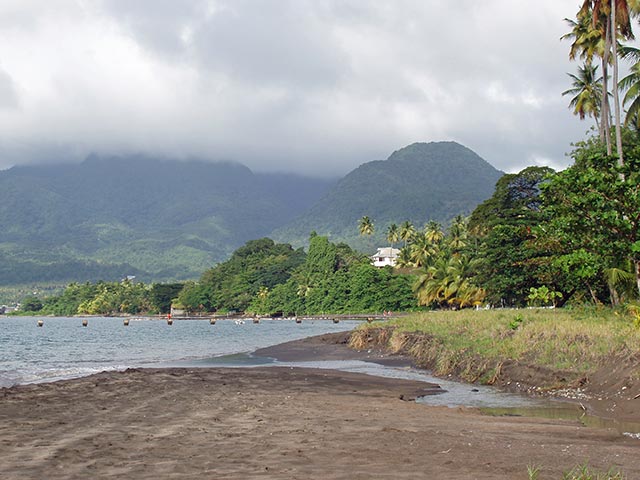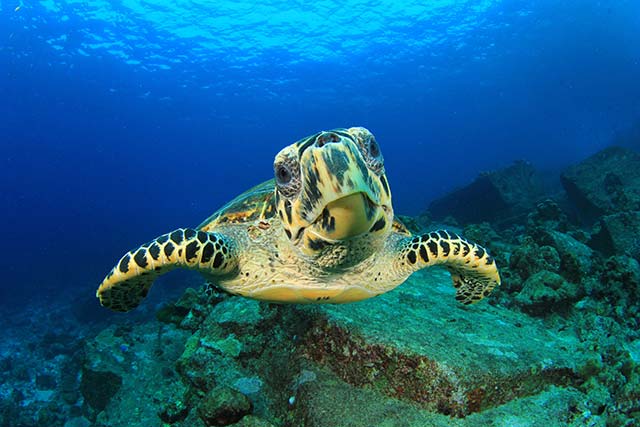

27 July 2021
Dominica's reefs are rocky: there are lots of corals here but they sit on boulders and walls rather than on reefs laid down by coral. The diving in Dominica currently is nearly all on the Caribbean side of the island. Yours will generally be the only dive boat at a dive site, especially in the North and Central areas.
Dominica has many invertebrates: sponges, crabs, sea fans, shrimps, crinoids, sea urchins; and also many small fish. The weather in Dominica is often rainy which can lead to reduced visibility. However, as the water is deep this quickly clears. The run-off from rivers gives lots of food for the filter feeders hence the exuberance of invertebrates. The North tends to be wetter than the middle.

Dominica mountains and sea
The dive sites of the South (Scotts Head) are more dramatic than the North, but we recommend doing some dives at the North, Central and Bottom as the diving is different in each area.
The best time to dive Dominica is between February and May. High season is from mid-December to mid-April, although Dominica is much quieter than most of the other Caribbean islands. Hurricanes might happen in September and October. Sea temperature is between 26 and 28oC and you might see whales at any time.
Some of Dominica's dive sites are in areas of volcanic activity, and Hot Sophia is one of those. Called Hot Sophia as a yacht called Sophia used to moor here. The dive begins with a descent down the marker buoy line to a sandy bottom at 27 meters. There is a gentle depression in the sandy bottom which is very hot to the touch and covers an area of several square meters: extremely strange to place your hands on the sea bed and for it to be hot. The remainder of the dive is around a reef which rises from the sea bed with lots of basket sponges, moray eels, some soft and hard corals. The dive is just a 5 minute boat ride from the Picard Beach Cottage Resort pier on the southern side of Price Rupert Bay, close to Portsmouth.
Dive Operator: Cabrits.
The dive site is a few hundred meters west of the cruise ship dock. Do not be put off by this as very few ships dock and there is no evidence of pollution or litter, in fact the dock itself is a night dive site. The dive site is buoyed and you drop to a rock bottom at 8 meters, the dive follows the line of the headland along a steep rocky slope covered in barrel sponges and hard corals. The slope descends to 25-30 meters where a sandy bottom is met. There is plenty of life and generally the visibility is good due to the shelter from the headland. A lovely dive over an unspoilt reef. One of the features of the diving in the North of Dominica are the enormous numbers of feather stars and sponges. This dive is called Shark's Mouth because of the appearance of the many basket sponges there which have jagged tops. The dive also features boulders dropped into the sea by a landslide, hard corals and many small fish including spotted morays (Gymnothorax moringa) and spotted drums (Equetus punctatus).
Dive Operators: Cabrits, East Carib.
Douglas Bay is the Bay north of Cabrits Head and is a 30-40 min boat ride from Portsmouth. The dive is below a cliff face and starts at a sandy bottom at 5 m. This slopes gently to 25 meters and is punctuated with coral blobs. The dive goes out and back in a loop. The entire dive has much hard coral - rounded like brain coral rather than branched. Look out for Flying Gurnards, Dactylopterus volitans. This uses its ventral fins (the small ones underneath at the front) to "walk" along the sea bed or to turn over rocks looking for small invertebrates to eat. When swimming it spreads its blue "wings" (enlarged pectoral fins) and looks lovely. There are also several types of moray to see: Gymnothorax moringa, Muraenia miliori and Myrichthysis oculatus. At the end of the dive you return to the shallows below the cliff where there are numerous huge boulders with swim throughs and rocky outcrops to amuse you while doing your safety stop

Photo credit: Harald Zahn, taken in Dominica
Dive Operators: Cabrits, East Carib.
This is the north west tip of Cabrits Head and has similar underwater geography to Sharks Mouth: a coral and rocky slope down to a sandy bottom at 25-30 meters. It is less sheltered but just as interesting with large barrel sponges, moray eels and lots of small fish - shoals of chromis, copper sweepers, rock beauties, butterfly fish, wrasse, trunkfish, goatfish, bigeye and more. There is also the occasional turtle. The dive follows the headland down to 25-30 m returning in the opposite direction in the shallower waters at 15-6 m.
Dive Operator: Cabrits
Very similar to Five Finger rock on the other side of the tip, a gentle rocky slope with sponges. Ends in a plateau below the rocks.
Dive Operator: Cabrits, East Carib.
This is the west side of Cabrits Head. Like all the dive sites in the North, Sunshine is full of colourful sponges. It is also a good place to see butterfly fish. Off the boat to 7 m plateau which then slopes down. The dive follows the headland either as a drift or an outbound dive, returning in shallower waters. Giant Anemones, Condylactus gigantea with Squat Anemone Shrimps, Thor amboinensis, smaller than my little finger. Many big feather stars.
Dive Operator: Cabrits
Like Sunshine is on the west side of Cabrits Head. This dive comprises a sloping bottom with hard coral mounds You swim along the slope one way and then back at a shallower level to the boat. An easy dive with plenty of life at 6 m below the boat. You may also see a hawksbill turtle.
Dive Operator: Cabrits
Very nice dive. Again a sloping bottom with hard corals. On the south west side of Cabrits Head. Look for Yellowline Arrow crabs, Stenorhynchus secticomis in cracks. These look like spindly shrimpy things. They have 10 legs, 2 bright blue claws and a reddish head. Another interesting crustacean to look for are pairs of Pederson Cleaner shrimps, Periclimenes pedersoni with the electric blue legs. Towards the end of the dive look for the male Sergeant Major fish (Abudefduf saxatilis) guarding round patches of purple eggs on boulders. They will have changed from their normal yellow colour to blue. The eggs take four days to hatch.
Dive Operator: Cabrits
Further south than Cabrits Dive's other dive sites, it takes 40 mins by boat but offers a different experience. The dive is on a small headland starting in 10 m of water. From the boat dive down along a reef on your left to a sandy sloping bottom. Follow the sand outward and round the headland. It is mostly a sandy bottom with scattered boulders and coral outcrops. Although not sounding much it offers a great selection of sea life. This is a good place to see some larger creatures like Southern Stingrays, Dasyatis americana, barracuda and turtles. After the dive you can snorkel to a nearby cave in the cliff wall.
Dive Operator: Cabrits
Not far from Heavenly Cove it can be the second dive on the way back to Portsmouth. It is in the middle of a large bay and, as the name suggests, is a plateau covered in Sea Plumes, Pseudoptergorgia spp. The plateau is at around 14 m. Pretty dive with big Southern Stingrays and barracuda.
Dive Operator: Cabrits
This dive is a few minutes boat ride north of the East Carib dive centre. As the name suggests this is a very gentle shallow dive, but do not be put off as it is great. The dive starts in 14 meters on a sandy bottom with fields of sea grass. If you look closely there are lots of things to see here: nudibranchs like the tiny Cheidonura hrundinia, large peacock flounders (Bothus lunatus), garden eels and goldspotted eels (Myriochthys ocellatus). The dive involves swimming in towards the rocky shore below a cliff, as you swim in the sand gives way to lots of boulders and rocks covered in corals. Here you might be lucky enough to see seahorses (Hippocampus erectus). As you reach the shore you meet boulders covered in wall-to-wall anemones at 2-3 m. Turn towards the jetty to look for a school of Caribbean Reef Squid, Sepioteuthis sepioidea, hanging in the shade. A very good dive that is different from many others.
Dive Operator: East Carib
Easy dive just a few minutes boat ride from the East Carib dive centre. The boat moors in 7 m. Swim down along a sandy bottom to a series of three coral outcrops. Very pretty with loads of shoals of fish.
Dive Operator: East Carib
This dive is a few minutes boat ride from the East Carib dive centre. The boat moors in around 10m on a sandy bottom. A sloping wall dropping to 36 m then gently sloping into deeper water. Rise up and back in a loop to the start. Look for Harlequin glass-slugs, Cyerce critallina. Theses are translucent with burgundy and white markings. The cerata (wavy projections) are often bordered with white.
Dive Operator: East Carib
A few minutes boat ride from the East Carib dive centre. The nose is a rock protuberance at 30 m. You dive down a steep slope to the nose, round the nose and then back up and round again. The bottom is sandy and at 36 m. A very enjoyable dive, especially pretty around the nose. Sea plumes towards the end of the dive. Plenty of hard corals and featherstars. There is also a good chance of seeing a turtle.
Dive Operator: East Carib
North of Soufrière Bay. Columns of hot bubbles rise from the hot sand and rocks. An unusual dive, but as it is so shallow and close to the shore you may a well snorkel as dive it. If you are driving south from Roseau towards Soufrière, look for a sign saying Champagne Bay. There is a small car parking area there. You need to pay a fee then walk down to the small beach along a newly built walkway. At the beach guides will offer to take you in but you can snorkel it on your own if you prefer. Swim out a little way to the left and you will see the bubbles.
You can extend the snorkel by swimming south to some caves and further out to sea there are a number of coral outcrops worth a visit.If you do want to do it as a dive then Nature Island Dive, Dive Dominica and Anchorage go there.
"It was like swimming in a class of champagne. Warm bubbles from the bottom of the ocean. Clear water and loads of reef fish"
Calvin
"It's good during the day - lots of little things in the sand, plus flying gurnard, eagle rays and usual suspects but our 2 night dives here have been something else - masses of sting rays, electric rays (23 on one dive), exhibitionist octopus, massive lobsters - exhilarating."
Sue
"60 feet of water intact upright great visibility easy access about 100 feet long and you can swim into the beach clean your gear and have a beer."
Bobby Easom, 2020
The diving around Scotts Head is much more dramatic than the North with much deeper dives and drop offs the norm. Generally the water is clear water with a huge numbers of schooling fish. The Scotts Head headland is the southern most point of Soufrière Bay which is an old volcano crater. This dive site is 45 mins from East Carib dive centre, around 20 mins from the Roseau based centres and a few minutes from Nature Island Dive.
The boat moors in around 10m on a buoy just off the tip of the headland where the Atlantic Ocean meets the Caribbean sea! The water is crystal clear in this area and full of schoaling fish (Jacks & Trevalleys). The dive follows the volcano crater on the Caribbean side of the headland. The crater forms an underwater cliff which plummets down into the blue and is very impressive; the dive follows the crater at water depth you choose and is covered in whip corals, gorgonia and soft corals after 20 mins it goes up gently to a plateau at 5-10m between the Caribbean and the Atlantic. This area is rocky boulders with lots of gullies and caves hence the name. Sea life included rays, barracuda and the schools of hunting Trevalleys. In the rocky plateau there are lobsters and crabs. A fantastic dive!
A shore dive can be done from the sheltered north shore of the headland, access is easy and there is a short swim out to the rim of the volcano crater.
Dive Operators: East Carib, Nature Island Dive, Dive Dominica, Anchorage.
This dive is on the opposite side of the same underwater volcano crater as Scotts Head, it is just north east of Soufrière a few hundred meters from the shore. The dive starts in around 10m on the crater rim before going into the crater and following the wall along. The drop off down into the crater is very impressive and there are huge schools of fish hunting up and down the crater wall. The dive then returns to shallower water and back along the crater rim in 10-15m back to the boat. Those with any air left can then sit in 9m on the crater rim and watch the fish come and go from the deep. A fantastic experience. On the way home you could do a second or better still a third dive\snorkel at Champagne.
Dive Operators: East Carib, Nature Island Dive, Dive Dominica, Anchorage.
"Several pinnacles which can be dived in many different ways - morays and other eels, lots of turtles, even a hammerhead shark on one occasion, rays, barracuda, cero,jacks, angelfish, different shrimps, lobsters, crabs, snappers, rainbow runners - huge variety."
Sue, France, 2009
Dive Operators: East Carib, Nature Island Dive, Dive Dominica, Anchorage.
"Visibility very good, drop off as deep as 200 ft wall. Sea life around and spectacular corals."
Calvin, 2008
Dive Operators: East Carib, Nature Island Dive, Dive Dominica, Anchorage.
"Just wonderful - swim through to magical area as well as great wall - barracuda, porcupinefish, always a turtle, scrawled filefish, lobsters etc in profusion. Often some current"
Sue, France, 2009
"Pinnacle with swim throughs, fantastic corals, clouds of fish, breathtaking scenery"
Sue Hutchings, 2011
Dive Operators: East Carib, Nature Island Dive, Dive Dominica, Anchorage.
"L'Abym is in the Scott's Head-Soufriere Marine Reserve. It is a wall dive just north of the village of Soufriere, dropping to over 1500 feet - though we didn't try to verify that! It's so colourful, full of sponges and corals with masses of fish, including sargassum trigger fish (my favourites) and our daughter saw a hammerhead there. "
Sue Hutchings, 2011
Tell us about your Dominica dives. Either fill in the form below or use our more detailed recommendations form. Any other comments on this site or Dominica? Let us know.




